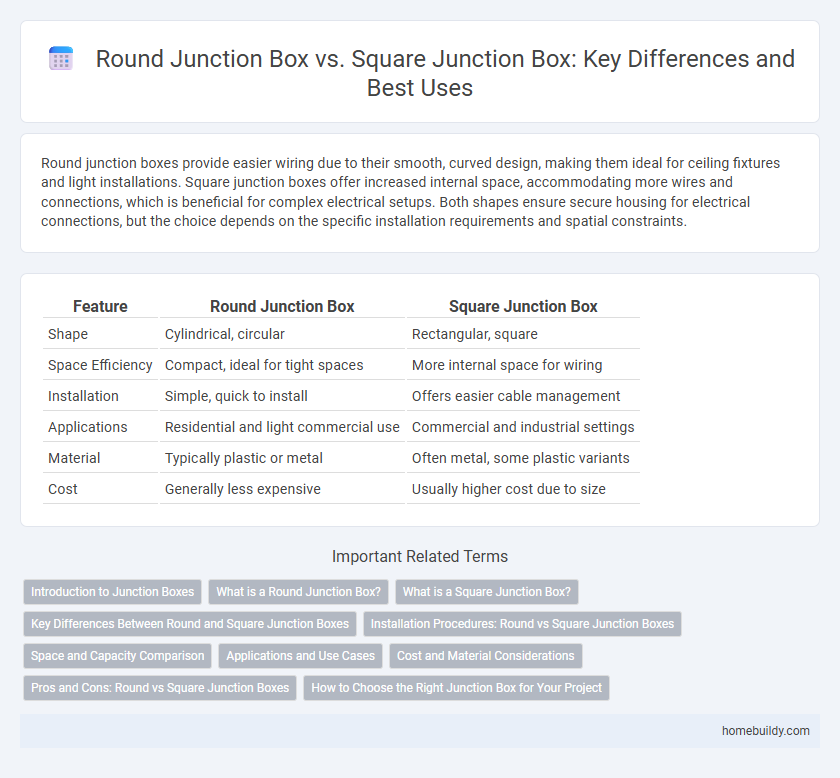Round junction boxes provide easier wiring due to their smooth, curved design, making them ideal for ceiling fixtures and light installations. Square junction boxes offer increased internal space, accommodating more wires and connections, which is beneficial for complex electrical setups. Both shapes ensure secure housing for electrical connections, but the choice depends on the specific installation requirements and spatial constraints.
Table of Comparison
| Feature | Round Junction Box | Square Junction Box |
|---|---|---|
| Shape | Cylindrical, circular | Rectangular, square |
| Space Efficiency | Compact, ideal for tight spaces | More internal space for wiring |
| Installation | Simple, quick to install | Offers easier cable management |
| Applications | Residential and light commercial use | Commercial and industrial settings |
| Material | Typically plastic or metal | Often metal, some plastic variants |
| Cost | Generally less expensive | Usually higher cost due to size |
Introduction to Junction Boxes
Junction boxes are essential electrical enclosures used to protect wire connections and ensure safety in wiring systems. Round junction boxes offer easy installation and are commonly preferred for ceiling fixtures due to their smooth shape, while square junction boxes provide more internal space, making them ideal for complex wiring setups and multiple connections. Selecting the appropriate junction box depends on the project requirements, wiring complexity, and spatial constraints.
What is a Round Junction Box?
A round junction box is a circular electrical enclosure used to house and protect wiring connections, ensuring safety and compliance with electrical codes. Its shape allows for easy routing of cables and is commonly used in ceiling or wall installations where compact design is essential. Round junction boxes typically accommodate light fixtures, smoke detectors, and other round electrical devices.
What is a Square Junction Box?
A square junction box is an electrical enclosure designed with four equal sides, providing ample space for wiring connections and device installations. It is commonly used in residential and commercial electrical systems to house switches, outlets, and wire splices safely. The shape allows for easier access and organization of cables compared to round junction boxes, making it ideal for complex wiring setups.
Key Differences Between Round and Square Junction Boxes
Round junction boxes typically offer easier cable entry and better fit for curved conduits, enhancing flexibility in wiring installations. Square junction boxes provide more interior space, accommodating multiple wire connections and allowing easier organization of complex wiring systems. Material compatibility and mounting options also vary, with square boxes often preferred for flush mounting, while round boxes are commonly used in ceiling fixtures.
Installation Procedures: Round vs Square Junction Boxes
Round junction boxes typically require a single circular hole for installation, making them easier to fit into drywall or ceiling materials. Square junction boxes, with their angular shape, often need precise measurements and rectangular cutouts, which can increase installation time and complexity. Both types must be securely fastened to studs or joists, ensuring proper grounding and wire management for safe electrical connections.
Space and Capacity Comparison
Round junction boxes typically offer more internal space relative to their outer dimensions, allowing easier wire management and accommodation of bulky connectors within a compact form. Square junction boxes provide greater surface area and compatibility with multiple conduit entries, enhancing capacity for complex wiring configurations in larger installations. Selecting between round and square types depends on installation space constraints and the volume of wiring or devices required inside the box.
Applications and Use Cases
Round junction boxes are commonly used in residential and commercial electrical installations where wiring needs to be joined in confined spaces or within circular conduit systems. Square junction boxes provide more internal space and are preferred for housing switches, outlets, and larger wiring connections, making them ideal for complex or high-capacity electrical setups. Both types ensure safety and organization but are chosen based on spatial requirements and specific wiring configurations in applications.
Cost and Material Considerations
Round junction boxes typically cost less due to simpler manufacturing processes and use of fewer materials, making them a budget-friendly choice for basic electrical installations. Square junction boxes, often made from heavier gauge metals or reinforced plastics, provide enhanced durability and protection but come at a higher material and production cost. When selecting between round and square junction boxes, consider the project's budget constraints alongside the required strength and longevity of the electrical enclosure.
Pros and Cons: Round vs Square Junction Boxes
Round junction boxes offer easier installation in confined spaces due to their smooth, curved design which reduces wiring congestion and is often preferred for retrofit applications. Square junction boxes provide greater interior volume for wiring connections, making them ideal for complex circuits or multiple conduit entries but can be bulkier and harder to fit into tight spots. While round boxes excel in flexibility and simpler projects, square boxes are favored for maximizing capacity and accommodating more wiring configurations.
How to Choose the Right Junction Box for Your Project
Selecting the right junction box depends on the project's spatial constraints and wiring needs; round junction boxes are ideal for ceiling fixtures due to their compact shape, while square junction boxes offer more internal space for complex wiring and multiple cable entries. Consider the mounting surface and compatibility with electrical devices, as square boxes often provide easier installation for switches and outlets. Prioritize durability, material type, and ease of access to ensure safety and compliance with electrical codes.
Round junction box vs Square junction box Infographic

 homebuildy.com
homebuildy.com